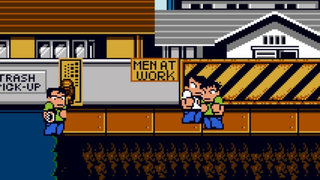River City Ransom creator dies
Mitsuhiro Yoshida's cult brawler was part of a string of other hits.

Mitsuhiro Yoshida, a Japanese designer best-known in the west for River City Ransom, has died at the age of 61. Yoshida's career will always be associated with the titles he worked on at Technōs Japan in the '80s and '90s, directing games like as Super Dodge Ball (Kōkō Dodgeball-Bu) and River City Ransom (Downtown Nekketsu Monogatari). He also worked on titles including Double Dragon and Nintendo World Cup (his softography is here)
In more recent times Yoshida founded and worked as president of the studio Miracle Kids!, which continued to work on Downtown / River City Dodgeball games, and which announced the news.
ご遺族の了承を得て代理でご報告します。ミラクルキッズ!代表 吉田晄浩が8月30日急逝しました。ダウンタウン熱血シリーズの生みの親であり、皆様に最高の新作をお届けしようと努力していた矢先の事で、大変残念です。故人に代わり、皆様の熱い応援に深く感謝いたします。スタッフ一同 pic.twitter.com/5pIwn1M9dtSeptember 3, 2022
The tweet's text says, machine translated and edited for clarity:
"We are writing on behalf of the bereaved family and with their consent.
Akihiro Yoshida, president of Miracle Kids!, passed away suddenly on August 30th."
[...] On behalf of the deceased, we would like to express our deepest gratitude for everyone's passionate support."
"All the staff."
PC Gamer Newsletter
Sign up to get the best content of the week, and great gaming deals, as picked by the editors.
Yoshida was apparently working on new titles right up until his death. His friend and colleague Hiroaki Ishida said, via an edited machine translation:
"I received the news of Yoshida's passing. It's a pity that the design of a new fighting action, which had been under the surface until about the year before last, has been left unfinished. If you are not healthy, you will not be able to make what you want to make, so everyone's health comes first."
Yoshida founded Miracle Kids! (sometimes stylised 'Kidz') in 2008, which released contemporary versions of some of the titles he was best-known for, including River City Dodge Ball All Stars!! and Downtown Smash Dodgeball.
But it's arguably River City Ransom that cements his legacy, a unique style of action-RPG that blended coherent locations and characters with a bit of good old ass-whooping. The series never quite acquired the traction overseas it had in Yoshida's home country, but this title was the biggest exception to the rule and remains a worthy cult classic.
Anyone with a particular interest in Yoshida's work may enjoy this treasure trove of design sketchbooks, where even from the first the series has that distinctly charming squat-grumpyman look.
Reminiscing about the games' origins back in 2016, Yoshida felt part of the design had come from his sense that a home game had to offer a different pleasure from the experience expected in arcades.
"I had a lot of doubts about the game's difficulty," recalled Yoshida. "I understand that arcade games increase the difficulty to increase the turnover rate of players, but aren't NES games bought with [childrens'] New Year's money? I wondered why even a game bought with precious New Year's money is an immediate death parade."
If you make such games double the difficulty, theorised Yoshida, then they become half as good.
"You can play for a long time... I wanted to create a balance with content, one that would allow a child who bought it with New Year's money to play until the New Year of the following year."
As any child who had River City Ransom might tell you: Yoshida achieved that, and then some.
Rich is a games journalist with 15 years' experience, beginning his career on Edge magazine before working for a wide range of outlets, including Ars Technica, Eurogamer, GamesRadar+, Gamespot, the Guardian, IGN, the New Statesman, Polygon, and Vice. He was the editor of Kotaku UK, the UK arm of Kotaku, for three years before joining PC Gamer. He is the author of a Brief History of Video Games, a full history of the medium, which the Midwest Book Review described as "[a] must-read for serious minded game historians and curious video game connoisseurs alike."
Most Popular





